The Slab Allocator in the Linux kernel
#include <linux/slab.h>
Author: Andrea Di Dio
If you have any further questions or suggestions after reading this writeup feel free to contact me at a.didio@student.vu.nl or on Twitter (@hammertux). I will try to answer any questions or adopt any suggestions :)
Introduction
Seeing as the Slab allocator is a fairly hard and advanced topic to grasp but also essential to start programming in the Linux kernel, I wrote this document which explains how it works. I will briefly explain what the buddy allocator is in order to make it clear why a slab allocator is handy in the linux kernel and then continue with a more detailed explanation of the slab allocator(s). This writeup has been written based on the 5.3.13 Linux kernel (latest stable release at the time of writing — Fri 15 Nov 22:13:17 CET 2019). I will illustrate what happens on x86-64 systems in which the page sizes are:
- Normal Pages: 4KB (defined as the PAGE_SIZE constant in the kernel).
- Huge Pages: 2MB or 1GB.
The Buddy Allocator
The basic idea of a buddy allocator is fairly simple. Physical memory is broken up into large chunks of memory where each chunk is a “page order” (i.e., 2^n * PAGE_SIZE). Whenever a block of memory needs to be allocated and the size of it is not available, one big chunk is halved continuously, until a chunk of the correct size is found. At this point, of the two halves, also known as buddies, one will be used to satisfy the allocation request, and the other will remain free. At a later stage, if and when that memory is free’d, the two buddies (if both free) will coalesce forming a larger chunk of free memory.
Note: Linux uses a buddy allocator for each memory zone. You are not necessarily expected to understand the notion of a memory zone. Generally speaking there will be DMA and DMA32 zones, highmem zone and a Normal zone and other zones (e.g., Zone Movable).
The buddy allocator keeps track of free areas via an array of “queues” of type struct free_area which keeps track of the free chunks (in reality we are talking about page frames –> struct page). It goes from 0 (min order) to 10 (MAX_ORDER - 1).
struct free_area {
struct list_head free_list[MIGRATE_TYPES];
unsigned long nr_free;
};
Note that the buddy allocator (and the slab allocator) allocate physically contiguous memory blocks. The third allocator in the Linux kernel, vmalloc() (which won’t be discussed for the time being) on the other hand, allocates memory that is ONLY virtually contiguous but not necessarily physical. It is primarily used for very large allocations, and cannot be used in cases where virtual addressing is not possible (e.g., devices)
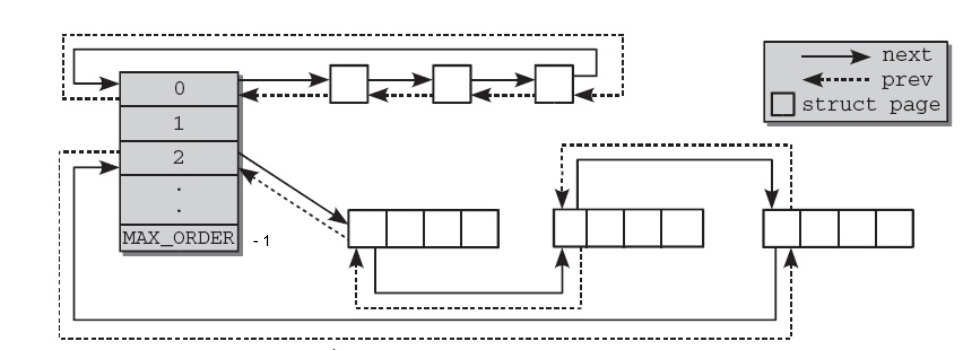
Page frames are allocated and free’d in the kernel using the following procedures:
// "linux/gfp.h"
static inline struct page *alloc_pages(gfp_t gfp_mask, unsigned int order);
/*
* e.g., to request one page: struct page *page = alloc_pages(GFP_KERNEL, 0);
*/
// "linux/page_alloc.c"
void free_pages(unsigned long addr, unsigned int order);
Both functions take the order as the parameter to see which queue to look for. If the queue is empty, the buddy allocator will search for queues in the bigger “orders” to split a block into two buddies and allocate the requested pages.
The GFP (Get Free Page) mask that is in the alloc_pages signature represents a set of flags that can be combined to represent who requests the memory allocation: e.g., GFP_KERNEL is used when allocating page frames for use in the kernel, GFP_USER is for userspace allocations, etc… (For a complete list of the GFP flags, see include/linux/gfp.h).
As it might be clear by now, the buddy allocator has one big problem. Say we want to allocate 33 pages. Seen as the buddy allocator works with the order queues explained above, the minimum amount of pages we can get is 2^6 = 64 because 33 > 2^5 (=32). This “wastes” 31 pages (i.e., for an allocation of 33 pages, we would have an overhead of 31/64 * 100 = 48\%). This is also known as internal fragmentation. This problem in Linux is addressed using the slab allocator which slices pages into smaller blocks of memory (slabs) for allocation.
Note that in reality, the linux kernel maintainers have optimised the buddy allocator by defining page mobility (i.e., some pages are reclaimable or movable) which reduces the overhead discussed above, however this is outside the scope of this writeup (if interested see the definition of enum migratetype in “linux/mmzone.h”).
The Slab Allocator
The slab allocator in Linux sits on top of the buddy allocator and the basic idea behind it is to keep caches of commonly used objects available for allocation in the kernel. This is particularly useful because the Linux kernel allocates and frees many structures continuously (for example, the struct task_struct which is the structure that represents a process, inodes, dentries, etc…). By caching the freed object, it is possible for the basic structure to be preserved between uses thus allowing for quick allocation of new copies of the same structures. I.e., By reusing the freed objects, in some cases, the kernel doesn’t necessarily have to reinitialise them from scratch. Over the years (and many kernel versions…) the Linux slab allocator has evolved, and changed substantially. There have been three different implementations to this day:
- SLOB Allocator: Was the original slab allocator as implemented in Solaris OS. Now used for embedded systems where memory is scarce, performs well when allocating very small chunks of memory. Based on the first-fit allocation algorithm.
- SLAB Allocator: An improvement over the SLOB allocator, aims to be very “cache-friendly”.
- SLUB Allocator: Has better execution time than the SLAB allocator by reducing the number of queues/chains used.
Nowadays (on most distributions) the default Slab allocator is the SLUB allocator.
Note: The generic “Slab Allocator” term can be used to refer to all three alllocators. Whenever there is the need to make a clear distinction between the allocators, I will write SLOB, SLAB or SLUB in capital letters.
A slab cache contains multiple slabs which in turn, contain multiple objects. The general organisational overview can be seen below:
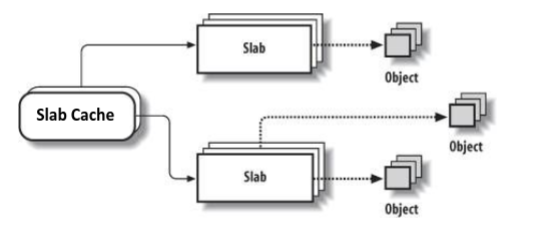
Caches
The slab allocator provides two main classes of caches:
- Dedicated: These are caches that are created in the kernel for commonly used objects (e.g.,
mm_struct,vm_area_struct, etc…). Structures allocated in this cache are initialised and when they are freed, they remain initialised so that the next allocation will be faster. - Generic (size-N and size-N(DMA)): These are general purpose caches, which in most cases are of sizes corresponding to powers of two.
This separation can be seen in the dedicated file for slab in the proc file system:
sudo cat /proc/slabinfo #I will only show partial output for brevity
# name <active_objs> <num_objs> <objsize> <objperslab> <pagesperslab> : tunables <limit> <batchcount> <sharedfactor>
# : slabdata <active_slabs> <num_slabs> <sharedavail>
vm_area_struct 65543 66082 208 19 1 : tunables 0 0 0 : slabdata 3478 3478 0
mm_struct 213 225 2112 15 8 : tunables 0 0 0 : slabdata 15 15 0
files_cache 228 230 704 23 4 : tunables 0 0 0 : slabdata 10 10 0
signal_cache 399 448 1024 16 4 : tunables 0 0 0 : slabdata 28 28 0
sighand_cache 414 435 2112 15 8 : tunables 0 0 0 : slabdata 29 29 0
task_struct 1102 1125 5952 5 8 : tunables 0 0 0 : slabdata 225 225 0
dma-kmalloc-256 0 0 256 16 1 : tunables 0 0 0 : slabdata 0 0 0
dma-kmalloc-128 0 0 128 32 1 : tunables 0 0 0 : slabdata 0 0 0
dma-kmalloc-64 0 0 64 64 1 : tunables 0 0 0 : slabdata 0 0 0
dma-kmalloc-32 0 0 32 128 1 : tunables 0 0 0 : slabdata 0 0 0
dma-kmalloc-16 0 0 16 256 1 : tunables 0 0 0 : slabdata 0 0 0
dma-kmalloc-8 0 0 8 512 1 : tunables 0 0 0 : slabdata 0 0 0
kmalloc-256 1801 2064 256 16 1 : tunables 0 0 0 : slabdata 129 129 0
kmalloc-192 4410 4410 192 21 1 : tunables 0 0 0 : slabdata 210 210 0
kmalloc-128 2689 2752 128 32 1 : tunables 0 0 0 : slabdata 86 86 0
kmalloc-96 6952 7350 96 42 1 : tunables 0 0 0 : slabdata 175 175 0
kmalloc-64 25933 26496 64 64 1 : tunables 0 0 0 : slabdata 414 414 0
kmalloc-32 15150 15616 32 128 1 : tunables 0 0 0 : slabdata 122 122 0
kmalloc-16 18432 18432 16 256 1 : tunables 0 0 0 : slabdata 72 72 0
kmalloc-8 10149 10240 8 512 1 : tunables 0 0 0 : slabdata 20 20 0
The first few lines show dedicated caches, from dma-kmalloc-256 onwards the generic caches are listed.
kmalloc is the interface the kernel provides to do generic allocations through the slab allocator:
// "include/linux/slab.h"
static __always_inline void *kmalloc(size_t size, gfp_t flags);
//allocates memory through slab allocator.
static inline void *kzalloc(size_t size, gfp_t flags);
//allocates memory (and zeroes it out like calloc() in libc) through the slab allocator.
void * __must_check krealloc(const void *, size_t, gfp_t);
//resize existing allocation.
void kfree(const void *);
//frees memory previously allocated.
void kzfree(const void *);
Creating dedicated caches for your objects is slightly trickier and requires initialising a slab cache (struct kmem_cache).
I will walk you through how a dedicated slab cache can be defined and used by taking the vm_area_struct’s slab cache as an example:
//"kernel/fork.c"
/* slab cache for vm_area_struct structures */
static struct kmem_cache *vm_area_cachep;
vm_area_cachep = KMEM_CACHE(vm_area_struct, SLAB_PANIC|SLAB_ACCOUNT);
/*
KMEM_CACHE() is a macro defined in "/include/linux/slab.h" which actually expands
to a call to kmem_cache_create() which is the procedure to register a new slab
cache and adds the new cache to the list of all slabs in the system.
*/
struct vm_area_struct *vma = kmem_cache_alloc(vm_area_cachep, GFP_KERNEL);
/*
kmem_cache_alloc() is the procedure to allocate the object from the dedicated
cache memory. The allocation will be attempted first on a partially filled slab,
then (if no partially filled slabs are available) in a free slab,
and if no free slabs are found,
it will try to allocate new page frames from the underlying buddy allocator.
*/
kmem_cache_free(vm_area_cachep, vma);
/*
kmem_cache_free() is the procedure that frees the memory allocated to the vma object
previously allocated. The (now free'd) slab,
will be kept in order to be used for future allocations and the memory is NOT
released immediately after this call. When all of the slabs have been free'd,
kernel modules have to call kmem_cache_destroy() to release the pre allocated memory.
*/
SLAB Cache Management
The three main structures that are used to manage caches in the SLAB allocator are:
struct kmem_cache(“/include/linux/slab_def.h”).struct kmem_cache_node(“/mm/slab.h”).struct array_cache(“/mm/slab.c”).
I have already showed that struct kmem_cache is exposed to the programmer in order to create a cache and allocate an object in the cache. Some fields of this structure are of particular importance:
unsigned int gfporder: defines the order (in powers of two – 2^n) of pages per slab. This is used by the slab allocator to request memory from the buddy allocator.void (*ctor)(void *obj): defines the constructor of the object which we want to allocate.int object size: size of the object being allocated through the slab cache.size_t colourandunsigned int colour_off: used for cache coloring (I will skip the details of cache coloring for the time being).struct array_cache __percpu *cpu_cache: Used to reduce the number of linked list traversals/operations. Has LIFO ordering to take advantage of cache hotness and aims to hand out “cache warm” objects. The membervoid *entry[]of this structure holds an array of recently freed pointers (i.e., free’d objects which are cache hot). Note that these pointers don’t preserve locality of access as the entry pointers can point to free objects in multiple page frames.struct kmem_cache_node *node[MAN_NUMNODES]: Used to keep track of slabs in different states, i.e., It keeps three linked lists (struct list_head slabs_partial,struct list_head slabs_fullandstruct list_head slabs_free) where each list holds, respectively, the slabs that are partially filled, the slabs which are full and the slabs that are free and can be allocated. It also contains an array of alien caches (struct alien_cache **alien) which is used to keep array caches for other nodes in the system.- Other fields are present for data management and debugging purposes but don’t add much to the understanding of the slab caches.
The interplay of these data structures and how the SLAB allocator helps to partition a page frame into separate chunks of objects is depicted below:
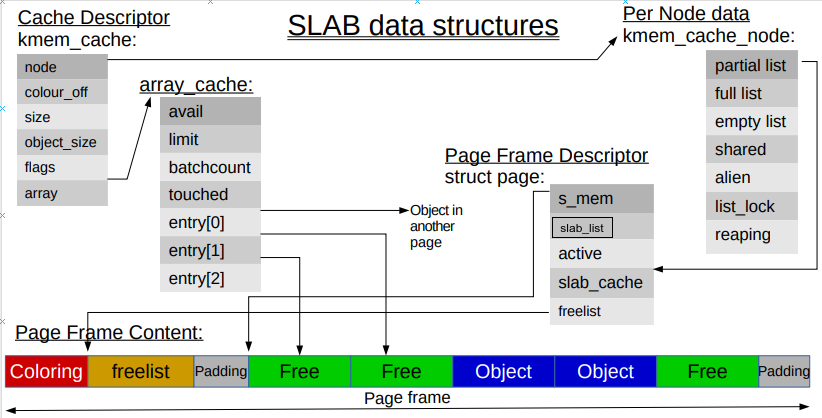
Note: In previous kernels, the developers where overloading the lru list in the page struct for maintaining lists of slabs. Today, this management is done via the slab_list. Seen as the image is older than this patch, I had to adjust it.
SLUB Cache Management
In the SLUB allocator things are less complicated because it stops keeping lists (queues) of different types, each cpu etc… Also the data structures used by SLUB are less cluttered and complicated thanks to these adjustments. The only queue that the SLUB allocator manages is a linked list for every of the objects in each of the slab pages. The idea was to minimise TLB thrashing by associating a slab page to the CPU (known as CPU slab) instead of a queue, so that we are only allocating objects within that page, meaning that we will be accessing the same TLB entry.
The SLUB allocator also uses three main structures to manage slab caches:
struct kmem_cache(“/include/linux/slub_def.h”).struct kmem_cache_cpu(“/include/linux/slub_def.h”).struct kmem_cache_node(“/mm/slab.h”).
As I did with the SLAB allocator, I will go through some fields of the struct kmem_cache which show how SLUB manages its caches:
unsigned int object_sizeandunsigned int size: These two fields represent, respectively, the size of the object without metadata, and the size of the object including the metadata.void (*ctor)(void *): defines the constructor of the object which we want to allocate.struct list_head list: represents the list of all active slab caches.struct kmem_cache_cpu __percpu *cpu_slab: This structure is used to keep track of the available objects in the cache. It contains two members of particular importance:void **freelistwhich points to the next available object andstruct page *pagewhich represents the slab page from which the allocation is happening (remember that SLUB, unlike SLAB, associates a slab page to every cpu instead of a queue).struct kmem_cache_node *node[MAN_NUMNODES]: This structure holds astruct list_head partialwhich is the only linked per cpu list that tracks partial slabs.unsigned int offset: Used to get the next free pointer in the slab page.
The interplay of these structures is showed below:
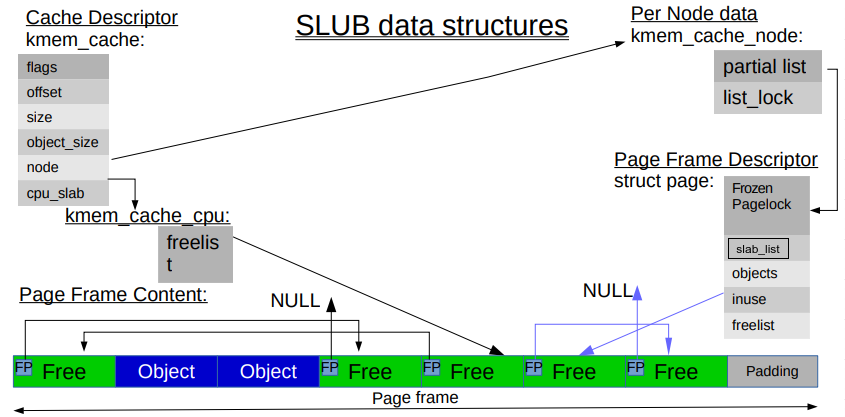
What about SLOB?
The SLOB (Simple List Of Blocks) allocator, is very different in nature from the SLAB and SLUB allocators because it doesn’t maintain cache descriptors, which makes object management very simple. The SLOB allocator keeps track of partially free slob pages in three separate freelists defined in "/mm/slob.c":
free_slob_small: freelist for pages containing objects smaller than 256 Bytes.free_slob_medium: freelist for pages containing objects smaller than 1024 Bytes.free_slob_large: freelist for pages containing all other objects (smaller thanPAGE_SIZE).
Even though cache management is essentially avoided, the SLOB allocator still provides the common interfaces such as kmalloc(), kfree, kmem_cache_alloc() and so on… These are however, only wrappers around the slob_alloc() and slob_free() functions which operate on the three lists mentioned above.
SLOB also has a very light support for NUMA architectures and only does node accounting, but makes the buddy allocator deal with per node allocation of pages. nevertheless, note that the three lists are node per-cpu lists and instead, are global, pages from all the nodes will be inserted in the three global lists.
Every time we try to allocate an object using the SLOB allocator, the slob_alloc() routine will iterate through each partially free page in one of the three lists (depending on the size of the object we are trying to allocate) and will try to do allocation using a first-fit algorithm. The obvious downside of this approach is that we can end up in a state in which the memory is heavily fragmented.
The interplay of these structures is showed below:
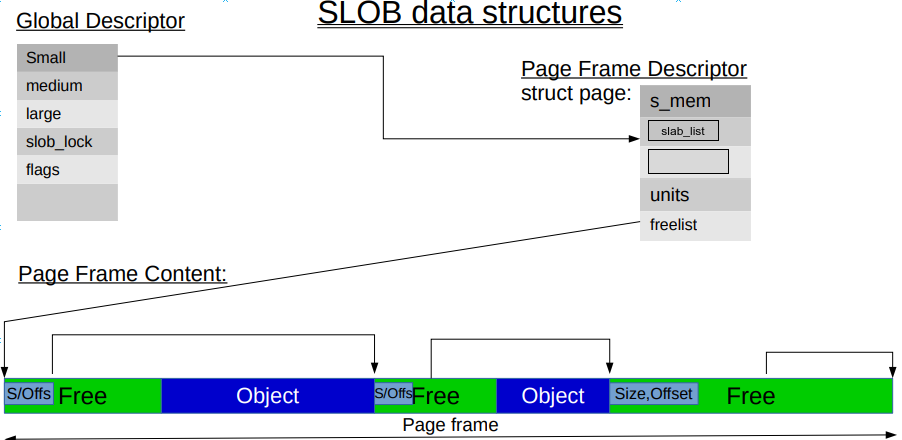
Slabs
Older kernel versions relied on a separate struct slab_s to define a slab. Nowadays, the slab management is kept into the struct page as an anonymous struct:
struct page {
.
.
.
struct { /* slab, slob and slub */
union {
struct list_head slab_list;
struct { /* Partial pages */
struct page *next;
#ifdef CONFIG_64BIT
int pages; /* Nr of pages left */
int pobjects; /* Approximate count */
#else
short int pages;
short int pobjects;
#endif
};
};
struct kmem_cache *slab_cache; /* not slob */
/* Double-word boundary */
void *freelist; /* first free object */
union {
void *s_mem; /* slab: first object */
unsigned long counters; /* SLUB */
struct { /* SLUB */
unsigned inuse:16;
unsigned objects:15;
unsigned frozen:1;
};
};
};
.
.
.
}
SLAB slab Management
I will first explain SLAB specific members in order to show the interplay with the structures explained in the Caches section for SLAB. Some of these structure members are more interesting and help with the understanding of how slabs are managed:
void *s_mem: Points to the start of an object in the page frame.struct kmem_cache *slab_cache: Used by thestruct kmem_cache_nodestructure to keep track of lists of all the pages.struct list_head slab_list: Used to keep track of which slab list(partial/full/free) this page frame belongs to.void *freelist: Is used to point to the first free object in the page frame. Intuitively, it contains indeces for every free object in the page frame. Allows multiple requests for free objects to be satisfied from the same cacheline.
The objects in SLAB which make up a slab page are rendered in memory as shown below:

SLUB slab Management
Before we look at the members used by SLUB for slab management, a brief explanation on how SLUB manages freelists is in order. To manage free objects, the SLUB allocator actually uses two freelists. The first, in the struct page which needs locking to be accessed, and the other one in the struct kmem_cache_cpu which is local and can be accessed/modified in a lock-free manner. The first is mainly used in the case where two objects in the same page have to be updated by different CPUs. The second freelist is used when we assign a slab page to the “per-cpu” structure. It takes the whole freelist off the page struct and puts it in the local kmem_cache_cpu structure and it can be used without locking. Once the local freelist is empty, it will poll the struct page to see if there are any new free objects and if so, it adds them to the local freelist.
Now, let’s take a look at some members of the struct page which are needed for slab management:
void *freelist: Points to the first free object in the page frame and can be accessed by different CPUs.unsigned inuse:16: Uses 16 bits as a counter which keeps track of the number of objects being used. Intuitively, when this counter is equal to 0, all objects are unused, and if necessary, the slab can be freed and the pages returned back to the kernel for future allocations.unsigned objects:15: Uses 15 bits to represent the total amount of objects in the page.
The objects in SLUB which make up a slab page are shown below:

SLOB slab management
Within a slob page, the SLOB allocator uses a few members from the struct page in order to manage object placement within a page:
void *freelist: Points to the first free object in the page. From the first free object it is possible to traverse the other free objects in the same page.void *s_mem: Points to the start of an object in the page frame.
The objects in SLOB which make up a slab page are shown below:
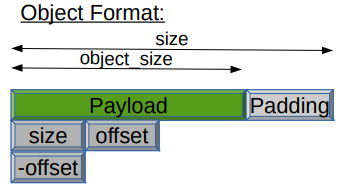
Slab Allocator Placement:
A (simplified) and general overview of the memory allocators in the linux kernel is depicted below:

At startup, the slab allocator does not have pages available quite yet. Through the use of two procedures, it can request page frames from the buddy allocator:
// "/mm/slab.c"
static struct page *kmem_getpages(struct kmem_cache *cachep, gfp_t flags,int nodeid);
// Asks the buddy allocator for pages for a particular kmem_cache.
static void kmem_freepages(struct kmem_cache *cachep, struct page *page);
// frees the pages previously allocated linked to a specific kmem_cache.
These two functions are some wrappers around the lower-level alloc_pages and free_pages (discussed in the Buddy Allocator section) which the buddy allocator exposes for page frame allocation. These wrappers are used in order to set all the metadata (i.e., flags) which represent allocations that go through the slab allocator.
Concluding Thoughts
In this writeup I have covered the basics of two of the memory allocators that live in the Linux kernel, i.e., Buddy allocator and Slab allocator. By this point it should be somewhat clear how they work together in order to increase memory usage. I have covered how SLAB and SLUB differ and gave a brief explanation of SLOB. I might cover vmalloc() in the future as well, possibly in a separate post. Hopefully the mm subtree is now slightly less scary :).
References
- Linux Kernel 5.3.13 Source Code
- LWN – Toward a more efficient slab allocator
- LWN – Cramming more into struct page
- Christopher Lameter’s awesome slides
- Buddy allocator, Slab allocator
- LWN – slab: overload struct slab over struct page to reduce memory usage
- Mel Gorman, Understanding the Linux Virtual Memory Manager (kern 2.6)
